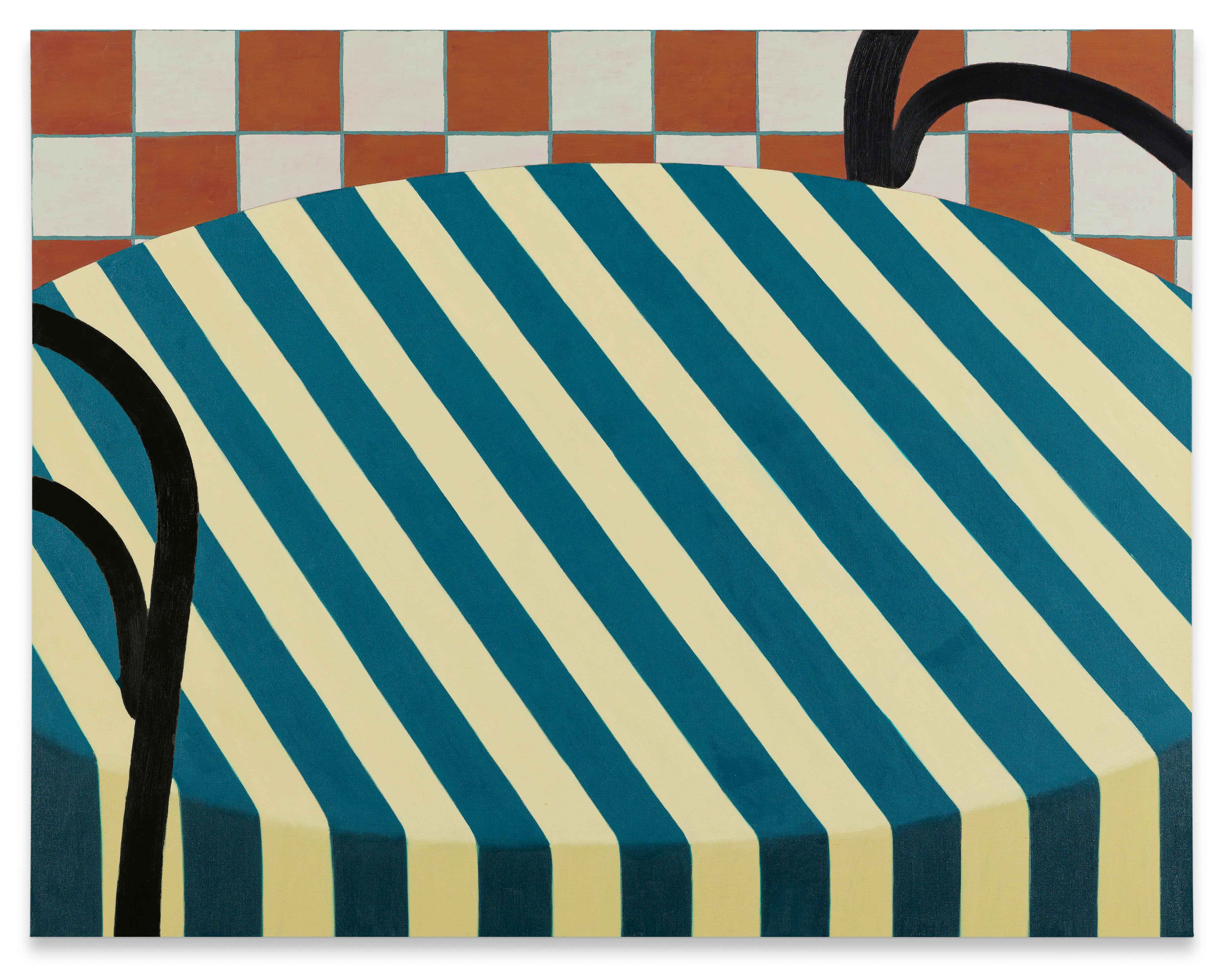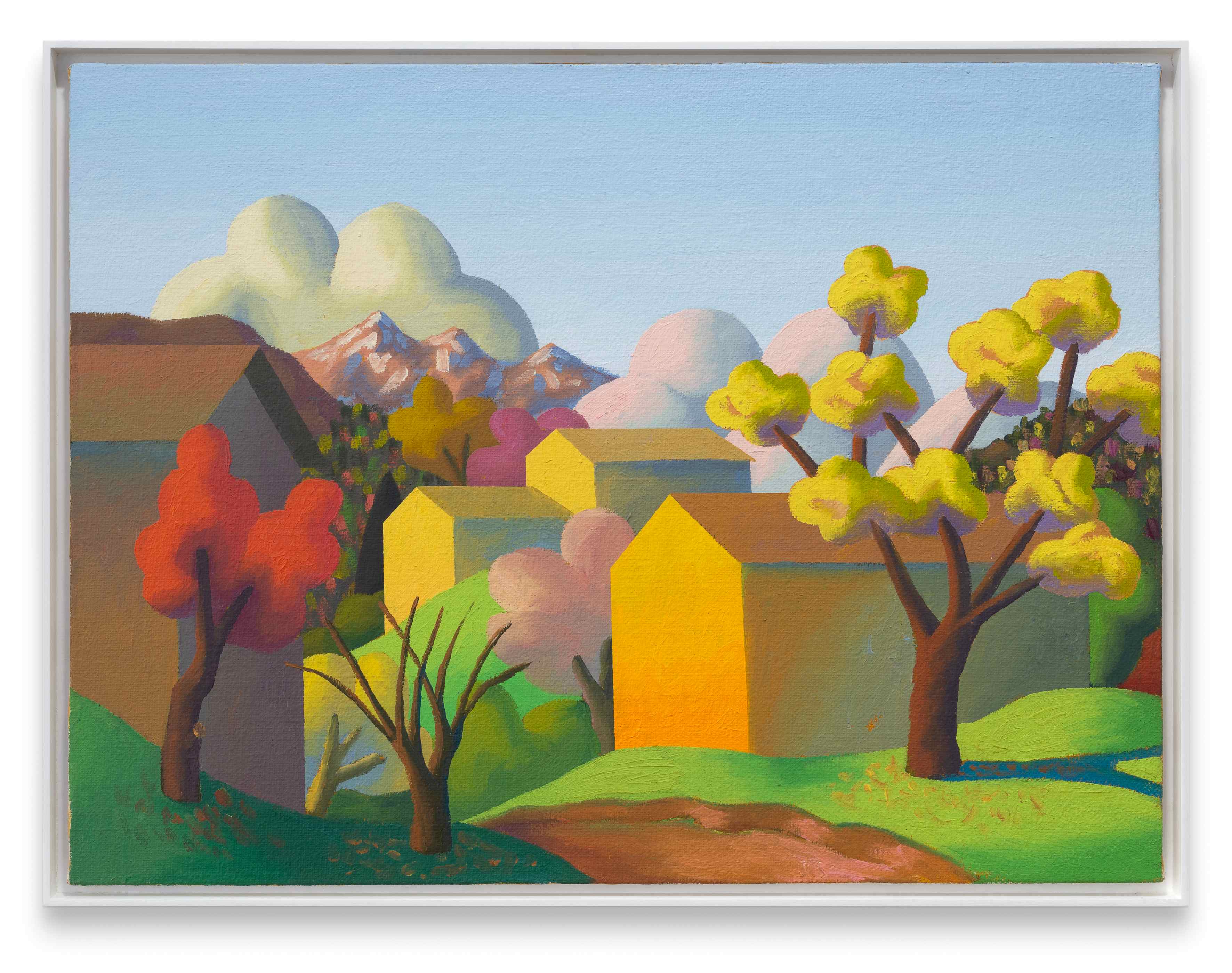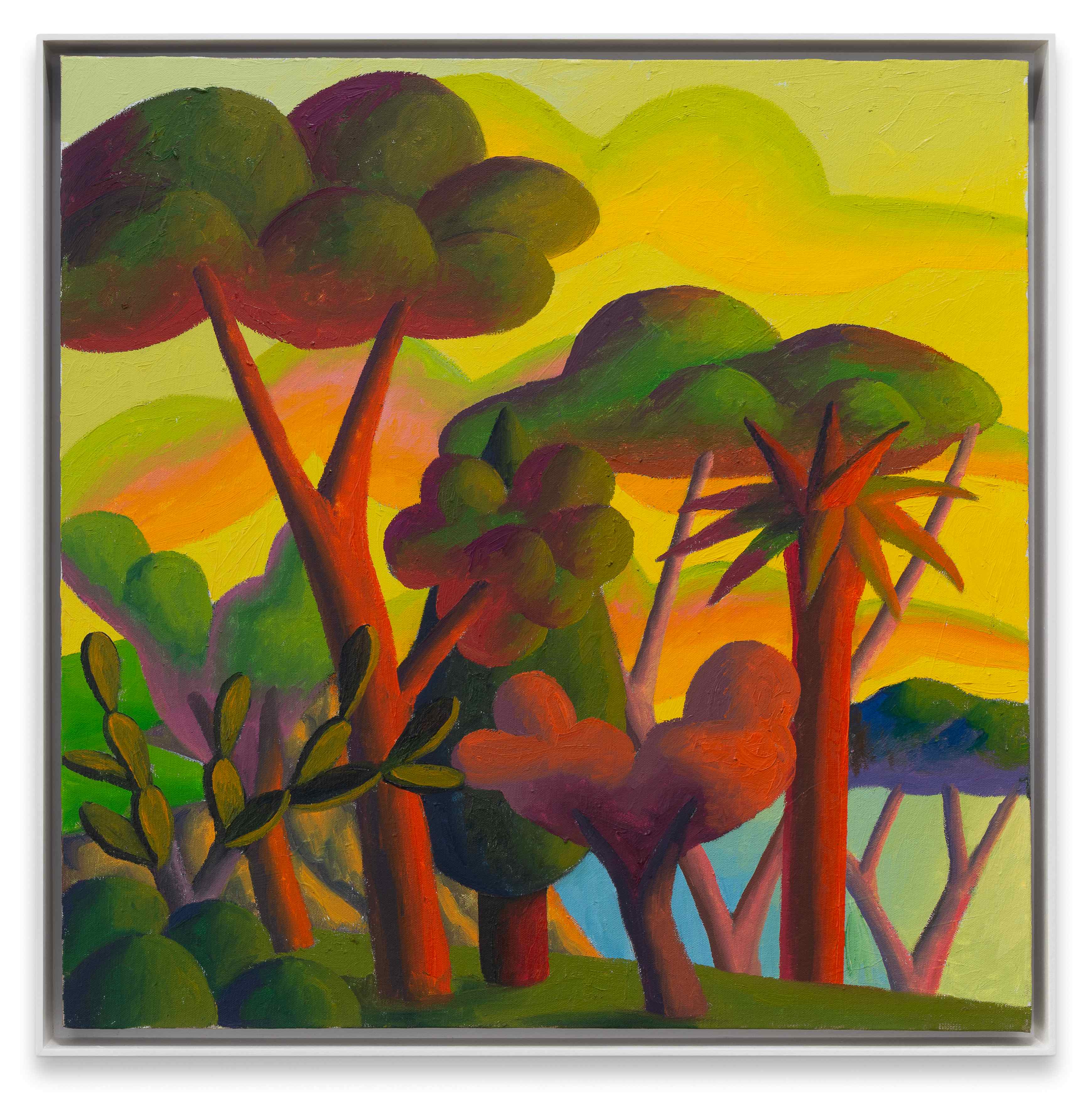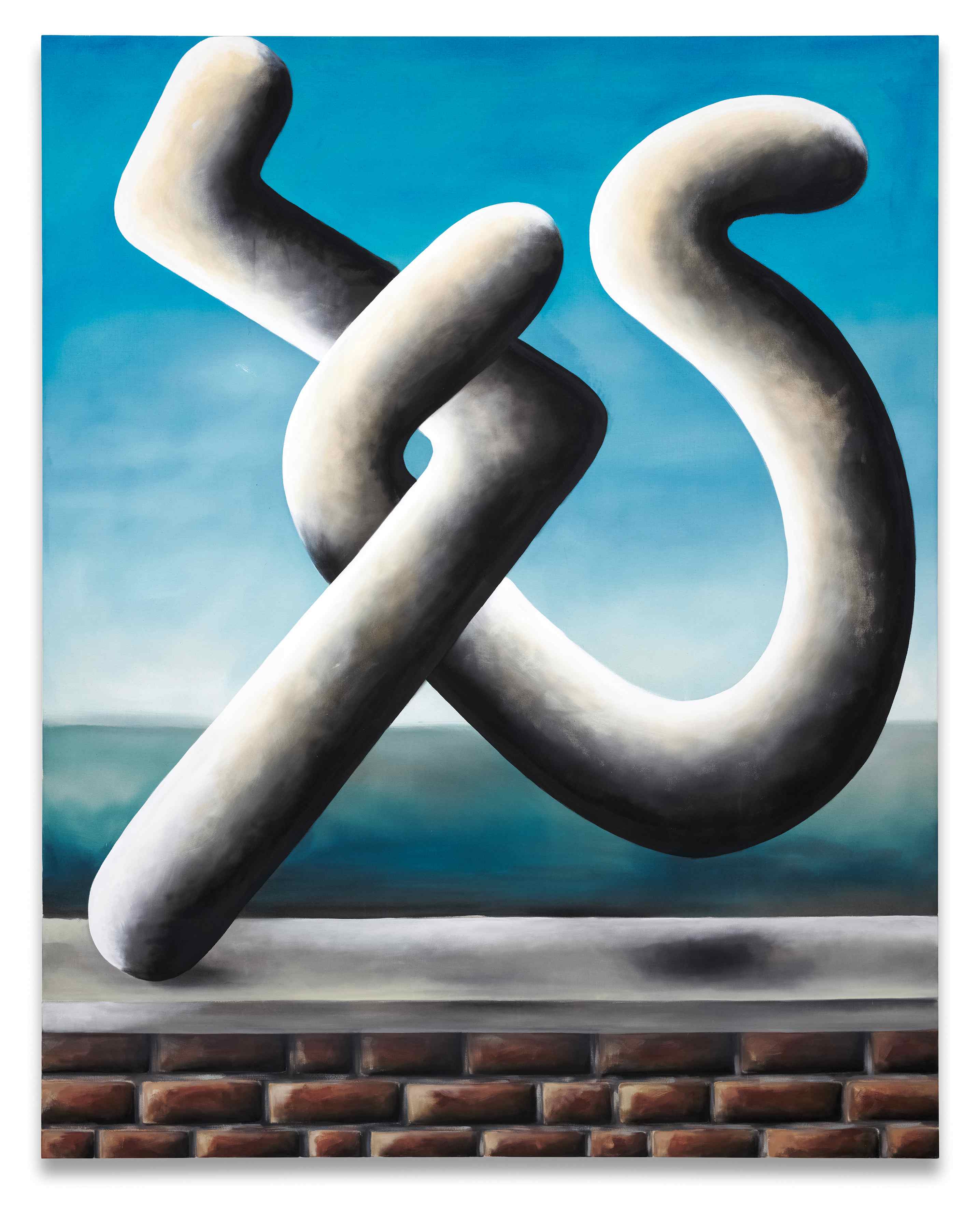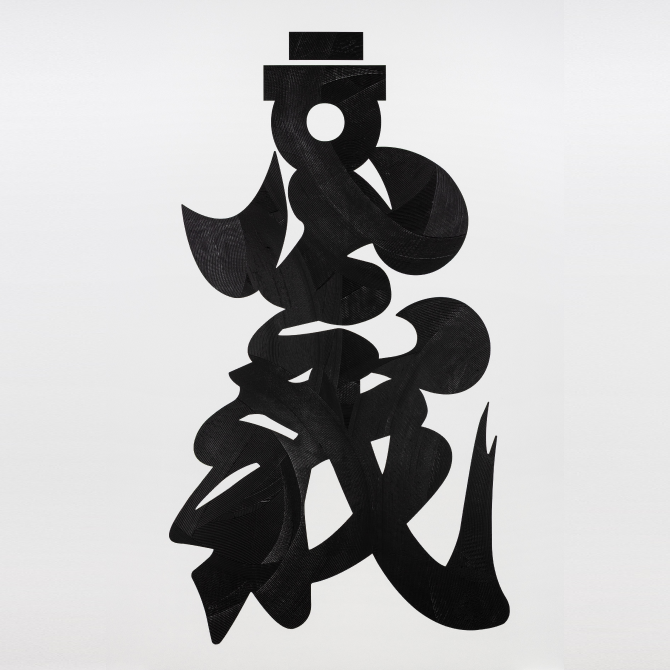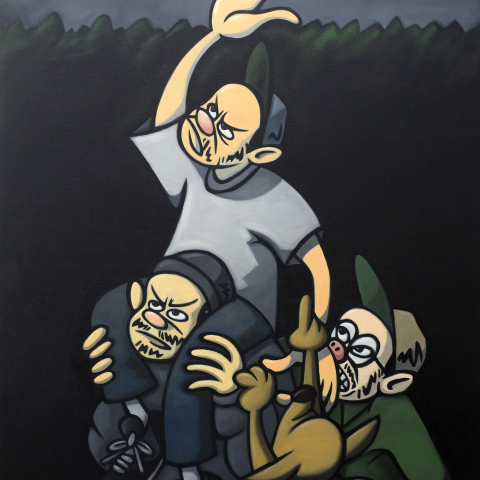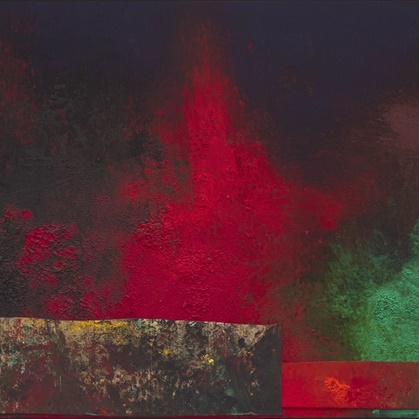분더샵 청담
About Painting
2025.09.03 -
2025.10.25
- 참여 작가
- 살보(본명 살바토레 만조네, 1947–2015)는 시칠리아 레온포르테에서 태어나 1956년 토리노로 이주했다. 1960년대 후반 토리노의 실험적 미술계에서 아르테 포베라와 개념미술에 관여하며, 빵·석탄·거울 등 비전통적 재료로 정체성·기억·예술과 사회의 관계를 탐구했다.
1973년 뉴욕 존 웨버 갤러리 개인전을 전후해 회화로 전환, 밝고 고양된 팔레트와 단순한 형태, 명료한 지평선과 축·대칭의 구도를 통해 새벽·대낮·황혼·밤의 빛을 설득력 있게 구축했다. 폐허의 건축, 인적이 지워진 도시와 해안은 정면 또는 약간 높은 시점에서 ‘정지된 시간’으로 제시된다. 그의 풍경은 상징적 서사보다 분위기를 강조하며, 매트한 색층과 얇은 글레이즈, 절제된 명암으로 장면의 ‘기후’를 만든다. 비평가들은 그의 회화를 ‘기억의 기후’를 조성하는 장치로 보며, 시칠리아의 채광과 토리노의 도시성이 만들어내는 긴장을 읽어낸다. 살보는 동시대 ‘회화로의 복귀’ 논의와 맞물리되 독자적 궤적을 구축했다.
안드레아스 슐츠(1955–)는 하노버 출생의 독일 화가로, 1980년대 쾰른에서 활동했으나 당대의 유행과 그룹 정체성에서는 거리를 둔 채 재현과 추상 사이를 오가며 일상의 정서를 유머와 아이러니로 비트는 자율적 언어를 구축했다.
대개 인물이 부재하는 그의 화면에는 테이블·의자·램프·카펫·소파·창틀, 교외의 주택과 정원 등이 주인공이 된다. 초현실주의·팝·추상표현주의의 어법을 교차하며 착시, 과장된 스포트라이트, 색의 리듬과 패턴의 반복, 스케일의 과장으로 익숙한 장면을 낯설게 전환하고, 친밀함과 미묘한 불안의 긴장을 연출한다. 그는 ‘회화적 숭고’에 대한 요구를 비켜가며 표면·형식·공간이 의미를 생성·해체하는 과정을 드러낸다. 작품 속에서는 무대적 도상이 반복되고, 대작에서는 색면·얼룩·흐름을 호출해 추상회화의 역사와 대화한다. 나아가 거대한 스케일의 설치적 전개로 공간을 조직하며, 관람자를 객석과 무대의 간극에 세워 ‘보는 방식’을 재조율한다.
헨니 알프탄(1979–)은 핀란드 출신, 파리 기반의 화가로 최소한의 형상과 절제된 구도를 통해 강한 내러티브를 만들어 낸다. 근접 촬영의 사진적 프레이밍을 회화의 문법으로 번역하며, 타이트한 크롭·얕은 초점·의도적 블러 같은 장치를 통해 이미지가 어떻게 만들어지고 의미를 갖는지를 화면 안에 질문으로 중첩한다.
알프탄이 만들어낸 장면은 특정 사건의 재현이라기 보다는 구성된 이미지로, 익숙함과 낯섦 사이의 경계를 미세하게 가로지른다. 영화·사진에서 기원한 hors-champ(프레임 밖) 개념이 핵심 요소로 작동해, 화면 밖의 암시가 관람자의 기억과 추론을 유도한다. 알프탄에게 회화는 ‘그려진 이미지’가 아니라 ‘그려진 대상’이며, 절제된 팔레트와 평평한 색층, 날카로운 에지 처리, 매트–미세 광택 대비가 느린 응시를 이끈다. 그녀는 캔버스 옆면까지 색을 확장하고 벽·여백·동선까지 고려해 작품—공간 전체를 하나의 조형 상황으로 설계한다. 화면들은 열린 서사로 남아, 관객의 추론으로 완성된다.
- 전시 내용
-
신세계갤러리 청담은 2025년 9월 3일부터 10월 25일까지 프리즈 서울을 기념해 유럽 출신 회화 작가 3인의 그룹전 《About Painting》을 개최한다. 이번 전시는 이탈리아의 살보(Salvo, 1947–2015), 독일의 안드레아스 슐츠(Andreas Schulze, b.1955), 핀란드 출신으로 파리에서 활동하는 헨니 알프탄(Henni Alftan, b.1979)을 한자리에 소개한다. 세 작가는 회화라는 매체를 해체하기보다는 회화의 고유한 방식으로 ‘보는 법’을 갱신한다.더보기
본 기획은 생전 살보, 슐츠 두 작가와 각별한 인연을 맺었던 고(故) 파스콸레 레체세의 제안에서 출발해 2024년 런던에서는 살보와 슐츠의 작품을 전시한 바 있다. 이번 서울 전시에서는 여기에 알프탄을 더해, 크롭, 프레이밍, 초점, 여백 등의 동시대 시각 문화의 언어를 회화의 방식으로 번역하는 현재의 감각을 포괄한다.
이번 전시는 빛과 시간—프레이밍—장면 구성이라는 세 축을 따라가며, 회화가 지각을 재조율하는 흐름을 제시한다. 전시는 살보의 작품 속에 밀도있게 녹아있는 색채와 시간의 정조를 점층적으로 체감하도록 설계되었다. 알프탄의 절제된 팔레트와 근접 프레이밍이 시선을 고요하게 열고, 슐츠의 강한 대비와 리듬이 맥박을 형성한다. 관람자는 색의 변주를 시간의 이동으로 읽어내게 된다.
살보는 1973년 전후 회화로 급선회한 이래 고전적 구도와 인공적 색채로 서로 다른 시간대와 계절의 자연광을 설득력 있게 구축해 왔다. 이번 전시는 계절과 지명이 제목이 되는 연작들을 중심으로 구성된다. 인물이 사라진 도시·해안·건축은 색과 빛의 기류로 시간이 가시화되며, 서로 다른 시간대의 팔레트가 기억과 정지된 순간을 조용히 불러낸다. 전시장에서는 이러한 작품군을 톤의 그라데이션과 시간의 시퀀스에 맞춰 배열해, 관람자가 색의 변화 = 시간의 이동이라는 흐름을 자연스럽게 따라가도록 했다.
안드레아스 슐츠는 인물이 사라진 공간에서 사물·기호와 건축적 단서를 장면처럼 배치해 의미가 연출되고 사라지는 순간을 장치한다. 특히 움직임과 동작의 기호를 덧입혀 화면의 리듬을 보강한다. 슐츠는 소박하고 직관적인 표현, 팝과 추상표현의 어법, 그리고 착시 효과를 교차적으로 활용해 유머와 미묘한 불안이 공존하는 광경을 만들고, 형식·구조·공간의 배치를 통해 의미가 생기고 사라지는 과정을 회화적으로 드러낸다. 결과적으로 관람자는 무대와 객석의 간극에 서서, 형식과 구조, 공간의 배치를 통해 회화가 무엇을, 어떻게 보게 하는지를 목격한다.
헨니 알프탄은 근접한 프레이밍, 얕은 초점, 의도적 블러 등 사진과 영화적 장치를 회화의 문법으로 환원한다. 더 나아가 캔버스의 옆면까지 색을 확장하는 방식으로 그림을 ‘그려진 대상(painted object)’로 다루며, 프레임 밖의 암시로 평평한 화면과 물건으로서의 존재감 사이의 긴장을 유지한다. 그의 장면은 일상의 순간을 포착하는 듯 보이지만 기억·상상·이미지에 대한 분석적 사유에서 출발하며, 관람자의 시선 습관을 스스로 다시 맞추게 만든다.
이번 서울 전시는 프리즈 서울이라는 동시대적 장 속에서, 디지털 이미지가 과잉 순환하는 현대에서 회화가 회복할 수 있는 감각의 속도와 물질적 존재감을 다시 일깨운다. 빠른 소비의 리듬에서 잠시 벗어나 회화의 언어를 따라 걸을 때 우리는 ‘그림을 본다’는 경험의 속도와 깊이를 다시 체감하게 된다. 《About Painting》은 서로 다른 세대의 실천을 병렬적이면서 상호참조적으로 제시하며, 우리는 무엇을, 어떻게 보고 믿는가라는 질문을 오늘의 서울에 다시 놓는다.
From September 3 to October 25, 2025, Shinsegae Gallery Cheongdam presents About Painting in celebration of Frieze Seoul, bringing together three European painters—Salvo (1947–2015, Italy), Andreas Schulze (b. 1955, Germany), and Henni Alftan (b. 1979, Finland; based in Paris)—who, rather than dismantling the medium, work from within painting’s own means to renew the act of looking.
The project originated with a proposal by the late Pasquale Leccese, who maintained close ties with Salvo and Schulze, and was first realized in London in 2024 as a two-person presentation. In Seoul, Alftan joins the conversation, extending it to include the contemporary visual lexicon—cropping, framing, focus, and negative space—translated into painterly terms.
Organized along three interwoven axes—light and time; framing; and the staging of the scene—the exhibition lays out how painting recalibrates perception. The installation is tuned so that viewers gradually register shifts of tone and tempo across the galleries. The route opens in quiet with Alftan’s restrained palette and close framing, accelerates through Schulze’s sharp contrasts and rhythmic shifts, and resolves in Salvo’s temporal sequence, where color grades into time—dawn to noon, dusk to night—so that chromatic change is read as the movement of time.
Since his decisive return to painting around 1973, Salvo developed a distinctive synthesis of classical composition and heightened, artificial color to evoke natural light across different hours and seasons. The Seoul presentation focuses on series titled after months and places, in which depopulated cities, coastlines, and architecture become temporal fields where light and hue render time visible. Works are arranged by gradations of tone and by a temporal sequence so that the viewer can follow color as a register of duration and memory.
Andreas Schulze constructs scenes in which objects, signs, and architectural cues inhabit emptied interiors and suburban structures like stage sets—moments where meaning is orchestrated and allowed to recede. Indicators of movement and action amplify the pulse of the picture. Working in a deliberately direct, unpretentious idiom that intersects with languages from Pop and Abstract Expressionism as well as subtle optical effects and patterning, Schulze produces images in which humor coexists with a subtle unease. Through his calibrations of form, structure, and space, painting shows how meaning emerges, shifts, and dissolves, positioning the viewer in the interval between stage and audience.
Henni Alftan translates devices from photography and cinema—tight crops, shallow focus, intentional blur—into a painter’s grammar. Extending pigment around the edges of the canvas, she treats the picture not as a flat image but as a painted object, sustaining a tension between the suggestion of space beyond the frame and the work’s physical presence. Her scenes appear to capture moments from daily life, yet they originate in an analytic probing of memory, imagination, and image-making itself, prompting viewers to reframe visual habits.
Set within the contemporaneity of Frieze Seoul, this iteration underlines the pace and material presence that painting can reclaim in an era of hyper-circulated digital imagery. Stepping aside from the tempo of rapid consumption, visitors are invited to move at painting’s cadence—recovering the depth and duration of the experience of looking. About Painting stages the practices of three generations in parallel and in mutual reflection, and returns the question to present-day Seoul: what do we see, how do we see it, and what do we choose to believe?
- 참여 작가
- 살보(본명 살바토레 만조네, 1947–2015)는 시칠리아 레온포르테에서 태어나 1956년 토리노로 이주했다. 1960년대 후반 토리노의 실험적 미술계에서 아르테 포베라와 개념미술에 관여하며, 빵·석탄·거울 등 비전통적 재료로 정체성·기억·예술과 사회의 관계를 탐구했다.
1973년 뉴욕 존 웨버 갤러리 개인전을 전후해 회화로 전환, 밝고 고양된 팔레트와 단순한 형태, 명료한 지평선과 축·대칭의 구도를 통해 새벽·대낮·황혼·밤의 빛을 설득력 있게 구축했다. 폐허의 건축, 인적이 지워진 도시와 해안은 정면 또는 약간 높은 시점에서 ‘정지된 시간’으로 제시된다. 그의 풍경은 상징적 서사보다 분위기를 강조하며, 매트한 색층과 얇은 글레이즈, 절제된 명암으로 장면의 ‘기후’를 만든다. 비평가들은 그의 회화를 ‘기억의 기후’를 조성하는 장치로 보며, 시칠리아의 채광과 토리노의 도시성이 만들어내는 긴장을 읽어낸다. 살보는 동시대 ‘회화로의 복귀’ 논의와 맞물리되 독자적 궤적을 구축했다.
안드레아스 슐츠(1955–)는 하노버 출생의 독일 화가로, 1980년대 쾰른에서 활동했으나 당대의 유행과 그룹 정체성에서는 거리를 둔 채 재현과 추상 사이를 오가며 일상의 정서를 유머와 아이러니로 비트는 자율적 언어를 구축했다.
대개 인물이 부재하는 그의 화면에는 테이블·의자·램프·카펫·소파·창틀, 교외의 주택과 정원 등이 주인공이 된다. 초현실주의·팝·추상표현주의의 어법을 교차하며 착시, 과장된 스포트라이트, 색의 리듬과 패턴의 반복, 스케일의 과장으로 익숙한 장면을 낯설게 전환하고, 친밀함과 미묘한 불안의 긴장을 연출한다. 그는 ‘회화적 숭고’에 대한 요구를 비켜가며 표면·형식·공간이 의미를 생성·해체하는 과정을 드러낸다. 작품 속에서는 무대적 도상이 반복되고, 대작에서는 색면·얼룩·흐름을 호출해 추상회화의 역사와 대화한다. 나아가 거대한 스케일의 설치적 전개로 공간을 조직하며, 관람자를 객석과 무대의 간극에 세워 ‘보는 방식’을 재조율한다.
헨니 알프탄(1979–)은 핀란드 출신, 파리 기반의 화가로 최소한의 형상과 절제된 구도를 통해 강한 내러티브를 만들어 낸다. 근접 촬영의 사진적 프레이밍을 회화의 문법으로 번역하며, 타이트한 크롭·얕은 초점·의도적 블러 같은 장치를 통해 이미지가 어떻게 만들어지고 의미를 갖는지를 화면 안에 질문으로 중첩한다.
알프탄이 만들어낸 장면은 특정 사건의 재현이라기 보다는 구성된 이미지로, 익숙함과 낯섦 사이의 경계를 미세하게 가로지른다. 영화·사진에서 기원한 hors-champ(프레임 밖) 개념이 핵심 요소로 작동해, 화면 밖의 암시가 관람자의 기억과 추론을 유도한다. 알프탄에게 회화는 ‘그려진 이미지’가 아니라 ‘그려진 대상’이며, 절제된 팔레트와 평평한 색층, 날카로운 에지 처리, 매트–미세 광택 대비가 느린 응시를 이끈다. 그녀는 캔버스 옆면까지 색을 확장하고 벽·여백·동선까지 고려해 작품—공간 전체를 하나의 조형 상황으로 설계한다. 화면들은 열린 서사로 남아, 관객의 추론으로 완성된다.
- 전시 내용
-
신세계갤러리 청담은 2025년 9월 3일부터 10월 25일까지 프리즈 서울을 기념해 유럽 출신 회화 작가 3인의 그룹전 《About Painting》을 개최한다. 이번 전시는 이탈리아의 살보(Salvo, 1947–2015), 독일의 안드레아스 슐츠(Andreas Schulze, b.1955), 핀란드 출신으로 파리에서 활동하는 헨니 알프탄(Henni Alftan, b.1979)을 한자리에 소개한다. 세 작가는 회화라는 매체를 해체하기보다는 회화의 고유한 방식으로 ‘보는 법’을 갱신한다.더보기
본 기획은 생전 살보, 슐츠 두 작가와 각별한 인연을 맺었던 고(故) 파스콸레 레체세의 제안에서 출발해 2024년 런던에서는 살보와 슐츠의 작품을 전시한 바 있다. 이번 서울 전시에서는 여기에 알프탄을 더해, 크롭, 프레이밍, 초점, 여백 등의 동시대 시각 문화의 언어를 회화의 방식으로 번역하는 현재의 감각을 포괄한다.
이번 전시는 빛과 시간—프레이밍—장면 구성이라는 세 축을 따라가며, 회화가 지각을 재조율하는 흐름을 제시한다. 전시는 살보의 작품 속에 밀도있게 녹아있는 색채와 시간의 정조를 점층적으로 체감하도록 설계되었다. 알프탄의 절제된 팔레트와 근접 프레이밍이 시선을 고요하게 열고, 슐츠의 강한 대비와 리듬이 맥박을 형성한다. 관람자는 색의 변주를 시간의 이동으로 읽어내게 된다.
살보는 1973년 전후 회화로 급선회한 이래 고전적 구도와 인공적 색채로 서로 다른 시간대와 계절의 자연광을 설득력 있게 구축해 왔다. 이번 전시는 계절과 지명이 제목이 되는 연작들을 중심으로 구성된다. 인물이 사라진 도시·해안·건축은 색과 빛의 기류로 시간이 가시화되며, 서로 다른 시간대의 팔레트가 기억과 정지된 순간을 조용히 불러낸다. 전시장에서는 이러한 작품군을 톤의 그라데이션과 시간의 시퀀스에 맞춰 배열해, 관람자가 색의 변화 = 시간의 이동이라는 흐름을 자연스럽게 따라가도록 했다.
안드레아스 슐츠는 인물이 사라진 공간에서 사물·기호와 건축적 단서를 장면처럼 배치해 의미가 연출되고 사라지는 순간을 장치한다. 특히 움직임과 동작의 기호를 덧입혀 화면의 리듬을 보강한다. 슐츠는 소박하고 직관적인 표현, 팝과 추상표현의 어법, 그리고 착시 효과를 교차적으로 활용해 유머와 미묘한 불안이 공존하는 광경을 만들고, 형식·구조·공간의 배치를 통해 의미가 생기고 사라지는 과정을 회화적으로 드러낸다. 결과적으로 관람자는 무대와 객석의 간극에 서서, 형식과 구조, 공간의 배치를 통해 회화가 무엇을, 어떻게 보게 하는지를 목격한다.
헨니 알프탄은 근접한 프레이밍, 얕은 초점, 의도적 블러 등 사진과 영화적 장치를 회화의 문법으로 환원한다. 더 나아가 캔버스의 옆면까지 색을 확장하는 방식으로 그림을 ‘그려진 대상(painted object)’로 다루며, 프레임 밖의 암시로 평평한 화면과 물건으로서의 존재감 사이의 긴장을 유지한다. 그의 장면은 일상의 순간을 포착하는 듯 보이지만 기억·상상·이미지에 대한 분석적 사유에서 출발하며, 관람자의 시선 습관을 스스로 다시 맞추게 만든다.
이번 서울 전시는 프리즈 서울이라는 동시대적 장 속에서, 디지털 이미지가 과잉 순환하는 현대에서 회화가 회복할 수 있는 감각의 속도와 물질적 존재감을 다시 일깨운다. 빠른 소비의 리듬에서 잠시 벗어나 회화의 언어를 따라 걸을 때 우리는 ‘그림을 본다’는 경험의 속도와 깊이를 다시 체감하게 된다. 《About Painting》은 서로 다른 세대의 실천을 병렬적이면서 상호참조적으로 제시하며, 우리는 무엇을, 어떻게 보고 믿는가라는 질문을 오늘의 서울에 다시 놓는다.
From September 3 to October 25, 2025, Shinsegae Gallery Cheongdam presents About Painting in celebration of Frieze Seoul, bringing together three European painters—Salvo (1947–2015, Italy), Andreas Schulze (b. 1955, Germany), and Henni Alftan (b. 1979, Finland; based in Paris)—who, rather than dismantling the medium, work from within painting’s own means to renew the act of looking.
The project originated with a proposal by the late Pasquale Leccese, who maintained close ties with Salvo and Schulze, and was first realized in London in 2024 as a two-person presentation. In Seoul, Alftan joins the conversation, extending it to include the contemporary visual lexicon—cropping, framing, focus, and negative space—translated into painterly terms.
Organized along three interwoven axes—light and time; framing; and the staging of the scene—the exhibition lays out how painting recalibrates perception. The installation is tuned so that viewers gradually register shifts of tone and tempo across the galleries. The route opens in quiet with Alftan’s restrained palette and close framing, accelerates through Schulze’s sharp contrasts and rhythmic shifts, and resolves in Salvo’s temporal sequence, where color grades into time—dawn to noon, dusk to night—so that chromatic change is read as the movement of time.
Since his decisive return to painting around 1973, Salvo developed a distinctive synthesis of classical composition and heightened, artificial color to evoke natural light across different hours and seasons. The Seoul presentation focuses on series titled after months and places, in which depopulated cities, coastlines, and architecture become temporal fields where light and hue render time visible. Works are arranged by gradations of tone and by a temporal sequence so that the viewer can follow color as a register of duration and memory.
Andreas Schulze constructs scenes in which objects, signs, and architectural cues inhabit emptied interiors and suburban structures like stage sets—moments where meaning is orchestrated and allowed to recede. Indicators of movement and action amplify the pulse of the picture. Working in a deliberately direct, unpretentious idiom that intersects with languages from Pop and Abstract Expressionism as well as subtle optical effects and patterning, Schulze produces images in which humor coexists with a subtle unease. Through his calibrations of form, structure, and space, painting shows how meaning emerges, shifts, and dissolves, positioning the viewer in the interval between stage and audience.
Henni Alftan translates devices from photography and cinema—tight crops, shallow focus, intentional blur—into a painter’s grammar. Extending pigment around the edges of the canvas, she treats the picture not as a flat image but as a painted object, sustaining a tension between the suggestion of space beyond the frame and the work’s physical presence. Her scenes appear to capture moments from daily life, yet they originate in an analytic probing of memory, imagination, and image-making itself, prompting viewers to reframe visual habits.
Set within the contemporaneity of Frieze Seoul, this iteration underlines the pace and material presence that painting can reclaim in an era of hyper-circulated digital imagery. Stepping aside from the tempo of rapid consumption, visitors are invited to move at painting’s cadence—recovering the depth and duration of the experience of looking. About Painting stages the practices of three generations in parallel and in mutual reflection, and returns the question to present-day Seoul: what do we see, how do we see it, and what do we choose to believe?












